Brownells: Designing for Efficiency and Growth
Brownells’ new Iowa distribution center has taken touches—and miles—out of the order fulfillment process and increased throughput with near 100% accuracy.
Retailers and distributors alike are grappling with the challenge of filling a variety of order profiles across multiple sales channels, including wholesale distribution, store replenishment and direct-to-consumer. Since that usually means executing an unprecedented number of item picks, the trick is to meet customer service expectations without throwing so much labor at the problem that it breaks the bank. It’s just as important to design the warehouse so associates aren’t walking a half-marathon every shift to fill orders.
Those were the challenges facing Brownells, a third-generation family business and one of the leading providers of firearm accessories, gun repair parts and gunsmithing tools to gunsmiths and general gun owners. Back in 2011, the company was operating out of a 100,000-square-foot building with limited automation that was built in 1973. Meanwhile, business, especially its online business, was booming. Add in the additional space required following an acquisition, and the facility was bursting at the seams.
“We needed more space, more capacity, more flexibility and we had to be cheaper and faster than our competitors,” says Joe McMullen, vice president of operations. “At the same time, our old facility had low ceilings, so we couldn’t expand the cube, and we were landlocked so we couldn’t expand out. We weren’t very efficient.”
To keep up with business, and to pick orders from an inventory of nearly 90,000 items, associates were walking as many as 13 miles during a 10-hour shift to get 5,000 orders out the door. Overtime was common. 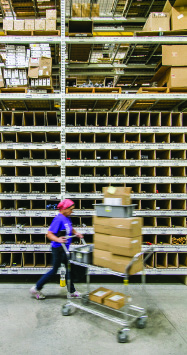
The solution? Working with a systems integrator (Sikich), Brownells developed a new 200,000-square-foot facility with capacity to fill as many as 10,000 orders per shift.
The new warehouse uses a conveyor and recirculation system and includes a custom warehouse management system (WMS) and hybrid picking solution (with order consolidation and put-to-light stations) that optimizes labor, space and slotting.
The 10 put-to-light stations can each handle up to 40 orders at a time, while a “fast-pack” station for items that ship in envelopes can handle up to 150 orders in a single batch. A flexible multi-level pick module was designed to minimize the amount of conveyor used in the facility while providing extra accumulation and recirculation.
And, Brownells is now an omni-channel business, serving not only its traditional wholesale and catalog business, but also an attached retail store (the company’s first foray into retail) that is highly visible from Interstate 80. A dedicated warehouse team picks as many as 300 orders a day that are conveyed directly into the store in about 10 minutes from the time a customer places an order on an in-store kiosk. “We wanted to go beyond just a traditional warehouse,” McMullen says. “The retail store allows us to better serve our customers and demonstrates that after 77 years, we’re stronger than ever.” 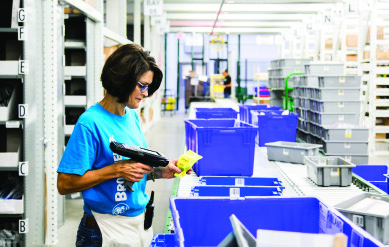
Since going live in 2014, McMullen says Brownells has seen a 37% increase in the number of orders picked per labor hour and a 67% increase in throughput capacity per shift. “We’ve gone from picking an average of 5,200 orders in a 10-hour shift to doing a little more than 8,500 in an eight-hour shift with near 100% accuracy,” he says. And, by using batch and zone picking methodologies, associates are no longer walking that half marathon to get their work done. 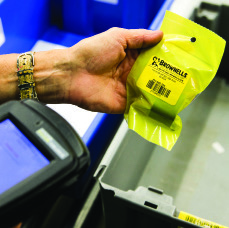
Bursting at the seams
Brownells was founded 77 years ago by Bob Brownell, the owner of a gas station and sandwich shop in his hometown of Montezuma, Iowa. An avid shooter and outdoorsman, Brownell enjoyed working on his own guns as well as those of his friends. By 1938, his hobby had grown into a part-time gunsmithing business.
Like many small businesses, Brownells grew out of necessity. Good gunsmithing tools were few and far between and when Brownell found something from one of the few gun supply catalogs that worked, he bought extras to sell to fellow gunsmiths. By 1947, he was ready to launch his first mail-order catalog with the motto, “The First and Only Complete Gunsmiths’ Supply House in the World.” 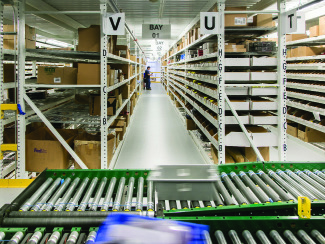
By 1951, he had closed his repair shop to concentrate full-time on the catalog and supply business. By 1973, with his son Frank as part of the business, the company moved into its first purpose-built facility in Montezuma, which still serves as the corporate headquarters.
Customer service was, and remains, at the heart of the business. Orders come with a lifetime guarantee: If your account is in the system, they’ll take it back—and the company staff includes experienced gunsmiths who are available to answer customer questions.
“We have the product to service firearms that are really old, and, if not, we’ll help you find it,” says McMullen. 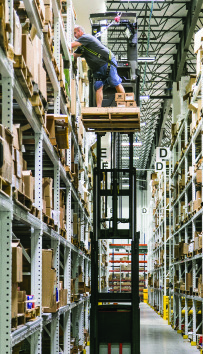
In the ensuing years, two more generations of the Brownell family have joined the business and taken leadership roles, with Pete Brownell, the founder’s grandson, serving as president. In 2000, the company launched Brownells.com to serve e-commerce customers and began to expand into new markets.
In 2007, it acquired Sinclair International to serve the market for long range, precision shooting and added ammunition as a major product category in 2011. Today, McMullen says that about 80% of the company’s sales arrive from e-commerce and the other 20% come from phone, e-mail, EDI and chat.
By 2012, when the company launched the site selection process for a new DC, the original warehouse could no longer keep up with organic growth, the addition of new product categories and the additional business that came from an acquisition.
“We had a very manual facility with just some takeaway conveyor from the picking area,” McMullen recalls. “We didn’t have a WMS, and to keep up with demand, we had to add people and work a lot of overtime.” Since orders couldn’t be batched, an associate might walk from one end of the warehouse to the other to pick an order complete, racking up miles during a shift.
What’s more, the growth of e-commerce heightened the need for customer service. “Customers can easily compare us to our competitors and many will make a decision based on how fast someone can get them a part because they’re working on a project or they’re planning to go hunting tomorrow.”
As Brownells planned the new facility with its systems integrator, McMullen and Jeff Coghlan, the senior business transformation manager, developed a list of criteria:
- automate where possible to reduce both touches and walking;
- implement a WMS system to enable more efficient slotting, allow batch and zone picking, bring discipline to management of highly regulated items like ammunition and manage multiple
- sales channels, including direct-to-consumer, wholesale shipments and the new retail store; and
- enable same-day shipment of customer orders.
In addition to those operational requirements, Brownells wanted a facility that would accommodate growth, and possibly other acquisitions, in the coming years. “One of the things we learned from acquisitions is that it’s hard to fit a square peg in a round hole, so we needed the flexibility to run different lines of business,” McMullen says.
As an example, a three-level pick module was designed so that it can be expanded easily in the future as needed. “We’re actively using all three levels, but for now the top level is only used for reserve storage and our slowest moving items. We could easily reconfigure and add to it,” McMullen says.
Introducing automation
The facility is divided into four primary work areas: receiving and quality control; reserve storage; the multi-level pick module; and the packing and shipping area. Specialized processes take place within those areas, such as a kitting area and a black powder room for the storage of ammunition near the reserve storage area.
They are tied together by a conveyor, sortation and recirculation system that routes totes throughout the facility, including directly into the attached retail store. The combination of the conveyor, WMS and zone picking in the pick module has dramatically reduced the amount of walking in the facility.
WMS-directed fulfillment operations take place in the multi-level pick modules. When orders drop into the facility they are assigned to a tote, which can hold up to 150 orders for the “fast-pack” area. At the first pick zone, an associate loads the totes onto a cart to pick orders in that zone. Once those are complete, the tote goes back onto the conveyor and is delivered to the next zone until it is complete. From there, the tote is sent to an accumulation area before it’s routed to the first available pack station.
According to Coghlan, a significant amount of work went into breaking down orders into their components, such as the number of pieces in orders and the products most frequently ordered. That information was then used to determine the best processes to flow product through the facility and the automation that could make that happen. For example, the “fast-pack” area is dedicated to single line orders that can be shipped in envelopes. Other packing areas were designed for small, medium and large cube orders using put-to-light technology to aggregate multi-line orders.
Also new was the special process to fill orders for customers who order from an in-store kiosk. Those orders go to a separate printer, where a small, dedicated team picks and packs them and gets them on the conveyor. The order also shows up on a monitor in the pick module; if someone has not begun processing it within a few minutes, its status turns red, alerting pickers to address the order.
“Retail customers have access to anything that’s in the warehouse, even if it’s not on the floor,” says McMullen. “That’s a competitive advantage for us.”
Culture counts
While the process changes were significant, the biggest change may have been cultural. Brownells has many employees who have been with the company for more than 20 years and were familiar with the old way of doing things. “As soon as you say automation,” says McMullen, “people wonder if robots are going to take their jobs.”
The company took a two-pronged approach to alleviate those concerns. First, it implemented the new WMS in the original Montezuma facility so that associates could get familiar with the system before the new facility went live. And, with a WMS in place, they also introduced the new batch picking process. “We wanted to ease the transition as much as possible, but it was still a big change,” Coghlan says. “So, we took time out of the schedule so that associates could walk through the new facility to see how it might work before we started up.”
Since going live, the facility has experienced significant increases not only in productivity, but also in customer service. For instance, the percentage of same-day ship orders increased 10% while also moving the order cut-off time back by an hour. Brownells has also found the processes are very flexible: The team can scale to handle spikes in order activity without bringing in additional labor.
The reduction in walking has also reduced turnover. Last, but not least, it’s easier to train new employees. “Because there are fewer touch points and fewer decisions, the training time is going way down,” says McMullen. “We can teach someone their job in a few minutes and in a matter of hours, they’re productive.”













